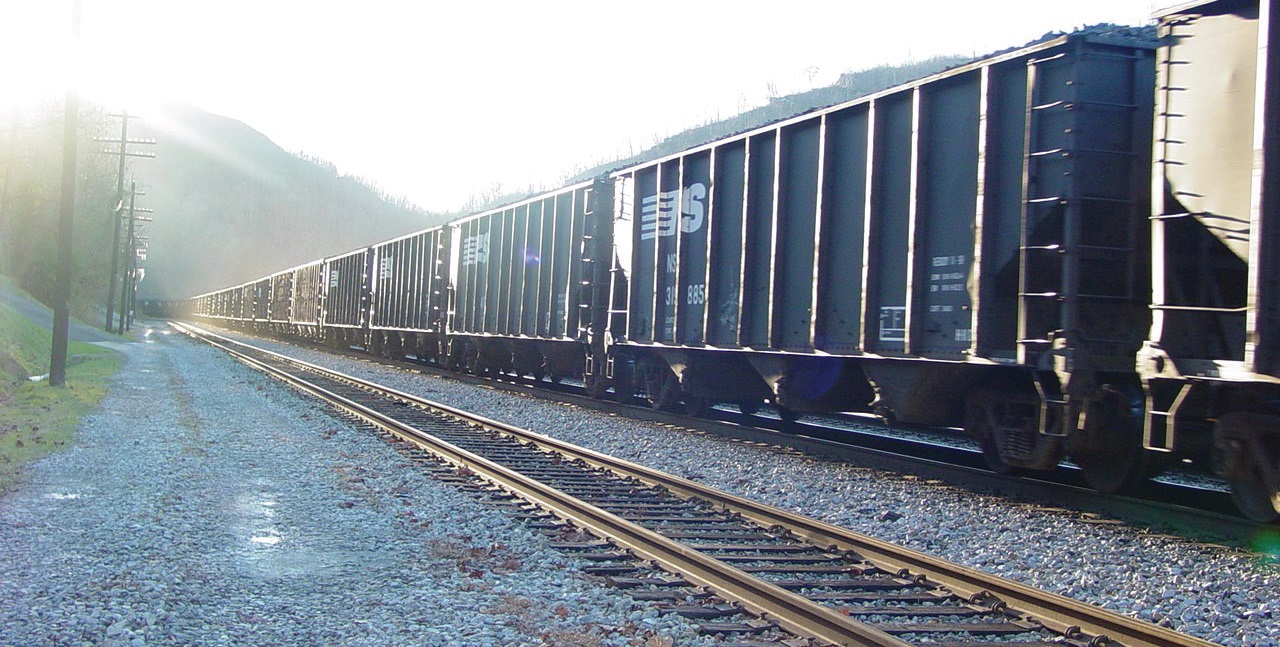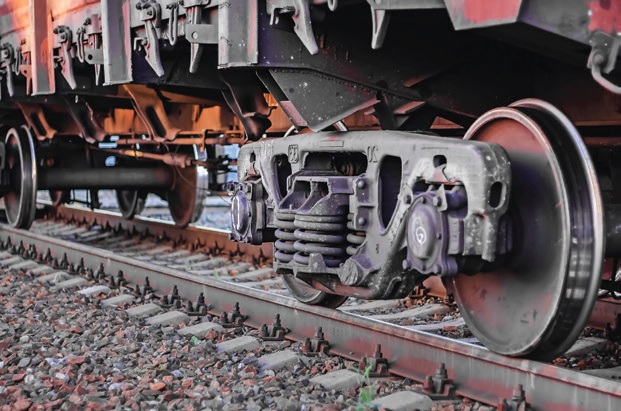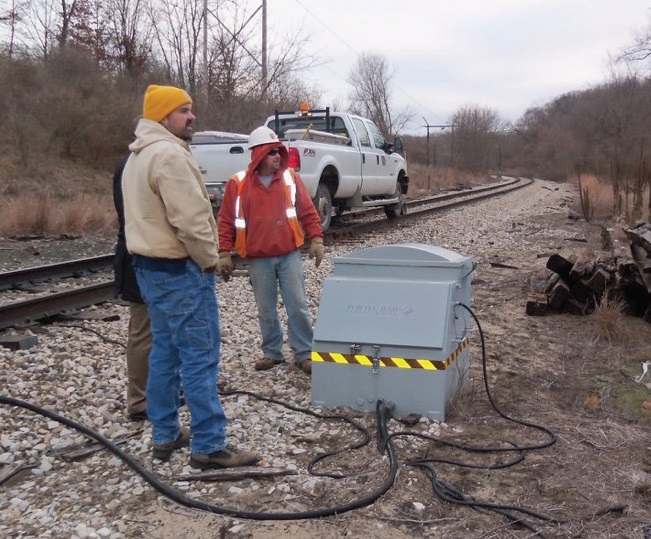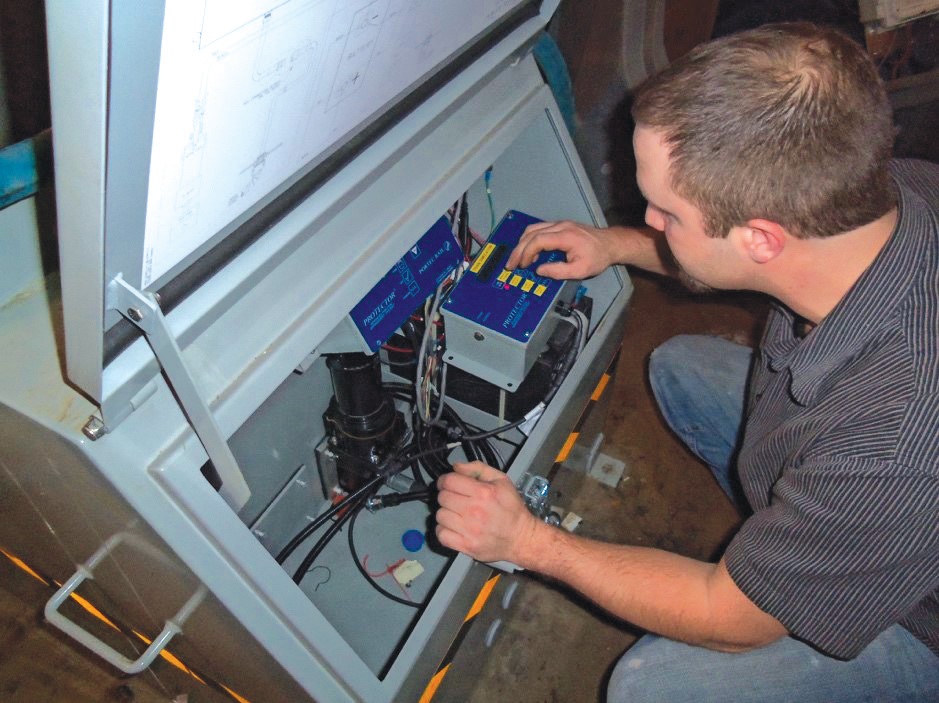.
Lubrication can help reduce noise in commuter rails.
Bio-based and synthetic greases can be effective alternatives to petroleum-based products.
Trains traverse the land, weaving disparate communities into a single fabric (
1). Ubiquitous, their presence is usually marked by their metal wheels clacking along metal tracks. On long, straight, flat rails, metal meeting metal moves the train along at a constant speed easily and safely. But come upon a curve, a hill or the end of the line and circumstances change. A curve needs slip, a hill needs traction, trains must stop.
Just because trains are an older technology does not mean they are simple. No steering wheels means that tracks guide the train. So railway lubrication must both cut friction and provide traction, work at a variety of temperatures in the environment and on the track and be pumped out of hoses and also stick to rails—all the while not accumulating in greasy pools along the way.
Many of the technical challenges of these complex issues have been addressed during the last several decades with petroleum-based and synthetic greases. Now there is a push toward biodegradable and biologically renewable products that can hold their own against petroleum-based ones.
Between the steel
There are three kinds of materials that address the way steel train wheels interact with the rails they ride on, according to Anup Chalisey, lead vehicle/infrastructure interface engineer at the UK’s Rail Safety and Standards Board (RSSB) (
2).
The first is flange grease. Flanges are the lips of the wheels facing the inside of wheelsets that keep the train from derailing. Operators apply grease to flanges to ensure the flange does not climb over the rail and to protect the wheel and rail on curves—usually on the high, outside rail of a curve. This reduces noise and the coefficient of friction, improving fuel efficiency and protecting the components from wear.
Next, trains need to stop. Adhesion materials such as sand provide friction to parts of the track where trains need to stop. Automated systems carefully dollop out just enough to stop but not to damage the wheels and rails.
Top of rail materials can help with a particular problem for trains—leaves on the tracks. Although rain’s traction-dampening effects can be short lived, leaves squish down and build up on the tracks, making them slippery. UK train operators deal with the problem by altering timetables for passenger trains. That way they can run fewer trains and run them slower, making them easier to stop.
“Autumn costs us 300 million pounds a season,” says Chalisey.
Top of rail lubricants also improve energy efficiency and help with noise. Because liquids can increase slipping and sliding, some systems squeeze liquid onto the rails that dries out and leaves solid particulates behind. These lubricants help manage the friction levels, but field testing these products is expensive because most operators don’t have test tracks.
“Top of rail materials have always had a long and difficult road in development,” says Chalisey. “Users and developers have to make sure they don’t lead to degradation in the safety of the railway.”
Along with colleagues throughout Europe, RSSB is currently developing top of rail standards for use in the European Union. In the UK, product developers generally can’t afford to do field tests themselves because they have to “borrow” tracks and perform tests when passenger trains aren’t running. In the U.S., grease developers can go to Pueblo, Colo., to six miles of test tracks at the Transportation Technology Center Inc. owned by the American Association of Railroads (
3).
Chalisey says the RSSB, with the European Lubricating Grease Institute (ELGI), is examining the half-dozen top of rail products already approved for use and running performance tests to understand what good performance is and what it isn’t.
The European standards will help the UK rail industry decide how far they want to take new products through expensive field tests. “If a new material meets these criteria, then it’s in the same ballpark of already-approved products and should be OK,” says Chalisey. “It gives them a better idea of whether or not they want to spend the money.”
 A railroad lubricant must know which side of the track is in the shade and which side is in the sun. (Photo courtesy of Lou Honary.)
Curves and cones
A railroad lubricant must know which side of the track is in the shade and which side is in the sun. (Photo courtesy of Lou Honary.)
Curves and cones
“Rail curve grease is one of the most complicated and complex products,” says Lou Honary, president of Environmental Lubricants Manufacturing, Inc. (ELM) (
4) in Grundy City, Iowa. Part of this is due to the many problems it has to solve: performing well in different temperatures, reducing friction while maintaining traction, having a balance of adhesion and cohesion to allow for adherence to the track and to pump from the grease reservoir, not accumulating on the tracks and cutting down noise.
Paul Bessette, president of Triboscience & Engineering (TSE) (
5) in Fall River, Mass., says noise is a bigger problem for relatively short commuter trains than for Class 1 freight trains that can be hundreds of cars long. Bessette’s company develops products used in passenger trains in Arizona.
“Commuter rail presents a different tribological challenge than freight rail lubrication,” he says. “Say you live in Chicago right next to the L (short for elevated) train on the second floor, and the train’s running right by your bedroom. The last thing you want to hear at 2 a.m. is the screeching of metal rubbing against metal when you’re trying to sleep.”
The heavy grating noise and the shrieking high-pitched noise that occur as a train hits curves are thanks to the geometry of the wheels and track.
A train’s wheels are a fixed width apart on a fixed axle. On straightaways, the wheels are both turning at the same speed and covering the same distance. On a curve, however, the fixed axle is still fixed—so the wheel on the inside of the curve has less distance to go than the wheel on the outside of the curve. The wheels are still turning at the same speed but have to cover different distances.
One way trains handle this is with wheels that are conical shaped rather than round with the widest part toward the inside of the track. A pair of wheels are taller toward the axle and shorter toward the outside of the train. The inside wheel rim (also known as the flange) extends below the top of the rail, securing the car on the track.
The cone shape helps the wheels pretend they are connected by a differential. On straightaways, the wheels are centered on the rails. On turns, however, the wheel-rail contact shifts from the center point of the cones to the taller side on one wheel and the lower side on its opposite. This makes the wheel going around the inner track of the curve slightly smaller and the outer wheel slightly larger, allowing both wheels to go roughly the same distances (
see Ref. 6 for a video showing how this works in an animation).
Even with that adjustment from the conical wheels, though, the wheel on the outside usually still slips. As the flange drags around on the rail, it creates both that heavy grinding noise and a high-pitched squeal (
see A Squeal By Any Other Means).
 © Can Stock Photo / nataliazhd
© Can Stock Photo / nataliazhd
A squeal by any other means
Railway tribologists and lubrication engineers have long thought the high-pitched screeching of trains going around curves is due to the flange scraping along the rail.
Anup Chalisey, an engineer with the UK's Rail Safety and Standards Board, says the squeal might be due to something other than metal rubbing together. This mechanism has to do with the shape of the wheel, which, as a reminder, is conical, similar to shapes and dimensions found in stereo speakers.
“The micro slip on the outer wheel causes the wheel to vibrate. The shape of the wheel is kind of speaker-like, in the way that it’s made. And the vibration causes a set of frequencies that can generate squeals,” he says (
11).
“Putting anything on top of the rail prevents the micro slip, which causes a change in the frequency, as anyone who has warped the music coming from a stereo by pressing on the speaker knows,” he says.
Bessette’s grease includes an additive that forms an organo-metallic film with the steel surfaces that makes the surface less prone to develop noise because of friction. “We use a chemical approach instead of a physical approach to solve these problems,” he says.
Honary points out that, in addition to reducing noise, railway greases need to be accommodating to their environments. “For the railroads, you actually need a smart product, a product that knows one side of the track is in the shade and one side of the track is in the sun. It needs to know the sunny side is warmer and the grease flows faster, that the shady side is colder and the grease is thicker. How do you deliver the same amount of product for each wheel as it goes by?”
To do this, a combination of tackifiers that respond to changes in temperatures are used.
“If it’s hot, the tackifiers expand and can slow the flow. If it’s cold, they will contract and create more flow. It’s like multi-season engine oil,” says Honary.
 Wayside lubricators dispense grease on tracks automatically. (Photo courtesy of Lou Honary.)
Ecological friendliness
Wayside lubricators dispense grease on tracks automatically. (Photo courtesy of Lou Honary.)
Ecological friendliness
The grease gets on the rail curves in one of two ways: wayside dispensers and train-bound systems.
The automated wayside dispensers are perched on the inside of the track. They pump the grease through a hose under the rocks in the middle of the track to a bar, where grease oozes out of tiny holes a half inch wide. The grease hits the rail on the inside curve, where the flange picks it up. As each wheel goes by, it will get a complete coating of grease on its flange going past the greasing bars.
Other dispensers are composed of reservoirs behind the wheels on the train. They use GPS sensors to spray lubricant on the tracks at the right time.
Because grease can accumulate on the ties and under the tracks, efforts to address environmental concerns have centered around three approaches: using less product, using renewable feedstocks and using biodegradable products.
Bessette is working with InterTran (
7) to combine TSE’s additive with an ester-based synthetic base. Their approach using synthetic lubes means they can function in all weather, he says. In addition, they have developed materials that can be applied at much lower rates (InterTran says to use half as much) through the onboard dispensing system.
“Our philosophy from an environmental stewardship standpoint is the less lubricant the better, regardless of how biodegradable it is. That is better stewardship for the environment than having to put gobs of lubricant along the tracks spit out by a roadside lubricator,” Bessette says.
Greases don’t have to be bio-based to be biodegradable. Some synthetic hydrocarbons, such as polyalphaolefins, that are used to make synthetic engine oil are known to be biodegradable.
“For Europe’s Ecolabel (
8), they decided not to worry about renewability and renewable hydrocarbons. Rather they are concerned about biodegradability,” says Honary. “PAOs score 40%-59% on biodegradability in standard tests.”
Greases based on vegetable oils are both biodegradable and renewable. Honary says there are additional advantages to vegetable oils that result in a superior product.
For example, the polarity of vegetable oil allows them to bond better to metals than mineral oils. Honary uses an analogy to magnets: vegetable oils, being dipolar, are like having one north and one south pole. Mineral oils are like a magnet shaped in a ball with many north and south poles and smaller attractive forces.
“With vegetable oil’s two very strong poles, you get a metal bonding effect; whereas in mineral oil, all that energy’s divided into many different poles, so it’s not as strong. The poles are still there but are dispersed. So they don’t bond as strongly to the metal as dipolar materials like vegetable oil,” Honary says.
 After checking conditions and the behavior of the grease, the equipment is programmed appropriately. (Photo courtesy of Lou Honary.)
After checking conditions and the behavior of the grease, the equipment is programmed appropriately. (Photo courtesy of Lou Honary.)
Besides bonding the metal surfaces, vegetable oils have a higher thin film strength, separating the metal-metal interface better. They also have a high viscosity index—as the temperature goes up, they don’t thin out as much as mineral oils and maintain their body better.
Lastly, Honary points out that vegetable oils also have a higher flash and fire point—200 F (93 C) higher than petroleum oils of the same viscosity—so they are safer from sparks that might occur during braking.
The variety of different vegetable oils allows formulators to explore different chemical properties. Honary has been developing bio-based oils since 1991. He established ELM in 2000 to commercialize bio-based rail grease based on work he did at the University of Northern Iowa’s National Agriculture-Based Lubricants Center in Cedar Falls, Iowa.
After more than 20 years in development, Honary and colleagues put their bio-based grease up against other mineral oil-based and bio-based products, including products from Plews and Edelmann, Shell and Whitmore (
9) in a Department of Transportation-funded study (
10) that came out in 2014.
In this study, they compared 12 products—half were winter versions and half were summer versions—both in labs and on commercial tracks. There they put the 12 products through laboratory, field and controlled environment tests that spanned temperatures between -10 to 100 F. The products had to perform in two different brands of wayside lubricators.
The results showed the bio-based products performed as well as the petroleum products in reducing friction and carrying down the tracks, going five miles down. The bio-based products also pumped as well in cold weather through typical equipment.
“The thing that we were proud of was the bio-based greases held their own,” Honary says. “They did pretty good. In some areas they did better. That in my view is the breakthrough: to deliver an environmentally friendly product that performs equal or better to the conventional product.”
Bio-based rail grease doesn’t start biodegrading until it’s in the soil with bacteria and rain. But a holdup in the widespread adoption of such greases has been their higher costs. In an ultimately positive twist of fate for ELM’s commercial development, a disastrous fire in 2007 wiped out the whole operation. They had been using an expensive heat transfer oil to heat up a reaction vessel to make grease.
“And then we had a fire that demolished everything. In 2010 we invented a new process and now we are making bio-based grease using microwaves,” says Honary, which has made prices competitive. “Nowadays we don’t use the environmental benefits as a selling point. We sell it based on performance and quality. The environmental adders are all icing on the cake.”
He also rebuts rumors that rodents and other animals are attracted to vegetable oils on the train tracks.
“These are not your vegetable oils that come out of food processing. By the time we turn it into grease, it has gone through several transformations. And the additives and materials we put in there are changing the texture and the taste. By no means does it have that property to attract animals, and we have added materials in lumber yards to repel rodents,” he says. “No reason to worry about that.”
With the many advancements in synthetic and renewable products, one ongoing challenge in railway lubrication, says Bessette, is how slow the railway industry evaluates new products.
“The railroads move glacially when they have to consider something that is more expensive and alien to what their knowledge base is,” Bessette says. “Once that inertia is overcome they will jump whole-heartedly into these synthetic type formulations, whether they’re produced by us or by other people.”
REFERENCES
1.
Interactive map of U.S. freight railways: Click
here.
2.
The Rail Safety and Standards Board:
www.rssb.co.uk.
3.
AAR Transportation Technology Center, Inc, Pueblo, Colo., American Association of Railroads:
www.aar.com.
4.
Environmental Lubricants Manufacturing, Inc.: Click
here.
5.
Triboscience & Engineering:
www.tselubes.com.
6.
How Do Trains Turn? video: Click
here.
7.
InterTran Corp.: Click
here.
8.
Ecolabel: European Commission: Click
here (Lubricant Substance Classification List, Part 1: Substances: Click
here).
9.
Whitmore: Click
here.
10.
A Study of the Use of Bio-Based Technologies (Lubricant and Grease) in Rail Applications, May 2014, DOT/FRA/ORD-14/11: Click
here.
11.
Staiano, M.A and Sastry, G. (1990), “Control of Wheel Squeal Noise in Rail Transit Cars,”
Transportation Research Record,
1255 (5), pp. 23-35. Available
here.
12.
Technical review: A Survey of Wheel/Rail Friction, September 2017, DOT/FRA/ORD17-21: Click
here.
Mary Beckman is a free-lance science writer based in Richland, Wash. You can contact her at mbeckman@nasw.org.